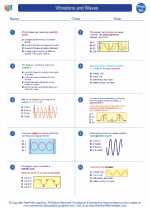Nuclear Decay
Nuclear decay, also known as radioactive decay, is the process by which an unstable atomic nucleus loses energy by emitting radiation. This process can result in the transformation of the original nucleus into a different element or a different isotope of the same element.
Types of Nuclear Decay
There are several types of nuclear decay, including:
- Alpha Decay: In alpha decay, an unstable nucleus emits an alpha particle, which consists of two protons and two neutrons. This results in the original nucleus losing two protons and two neutrons, thereby transforming into a different element.
- Beta Decay: Beta decay involves the emission of a beta particle, which can be an electron (β-) or a positron (β+). This type of decay results in the transformation of a neutron into a proton (in the case of β- decay) or a proton into a neutron (in the case of β+ decay).
- Gamma Decay: Gamma decay occurs when an excited nucleus releases excess energy in the form of gamma radiation (γ). This type of decay does not result in a change in the atomic number or mass number of the nucleus, but it leads to the nucleus transitioning to a lower energy state.
Radioactive Decay Equations
Radioactive decay can be described using decay equations, which show the transformation of a radioactive nucleus into a different nucleus through the emission of particles or radiation. The general form of a radioactive decay equation is:
Original Nucleus → New Nucleus + Particle(s) or Radiation
Half-Life
The half-life of a radioactive substance is the time it takes for half of the radioactive nuclei present in a sample to decay. It is a characteristic property of each radioactive isotope and can be used to determine the rate of decay of a substance.
Applications of Nuclear Decay
Nuclear decay has numerous applications in various fields, including medicine (e.g., nuclear medicine for imaging and treatment), energy production (e.g., nuclear power plants), and dating archaeological artifacts (e.g., carbon-14 dating).
Study Tips
When studying nuclear decay, it's important to:
- Understand the different types of nuclear decay and their characteristics.
- Be familiar with the concept of half-life and how it is used to measure the rate of decay.
- Practice writing and balancing radioactive decay equations.
- Explore real-world applications of nuclear decay to gain a deeper understanding of its significance.
Remember to review the fundamental principles of nuclear physics and atomic structure to build a strong foundation for understanding nuclear decay.
[Nuclear Decay] Related Worksheets and Study Guides:
.◂Physics Worksheets and Study Guides High School. Vibrations and Waves

 Worksheet/Answer key
Worksheet/Answer key
 Worksheet/Answer key
Worksheet/Answer key
 Worksheet/Answer key
Worksheet/Answer key
